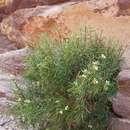en
names in breadcrumbs


Daphne mucronata is a shrub, of the family Thymelaeaceae. It is native to western Asia, ranging from eastern Turkey to the Arabian Peninsula, Iran, Afghanistan, Pakistan, and the western Himalayas.[2]
The shrub is evergreen, and grows to 2.5 m tall. Its slender branches are pale green. It is often found near river banks at around 800–3000 m elevation.[3]
The leaves contain poisonous properties that are not potent towards goats and the bark can be used to heal bone diseases and for washing hair. The fruits it bears are edible and can be used as a dye.[3]
Three subspecies are accepted:[2]
Daphne mucronata is a shrub, of the family Thymelaeaceae. It is native to western Asia, ranging from eastern Turkey to the Arabian Peninsula, Iran, Afghanistan, Pakistan, and the western Himalayas.